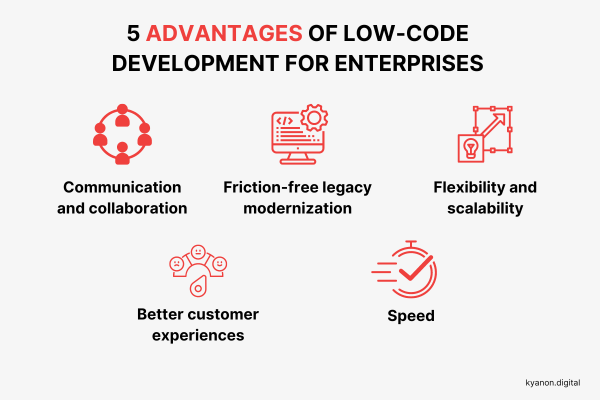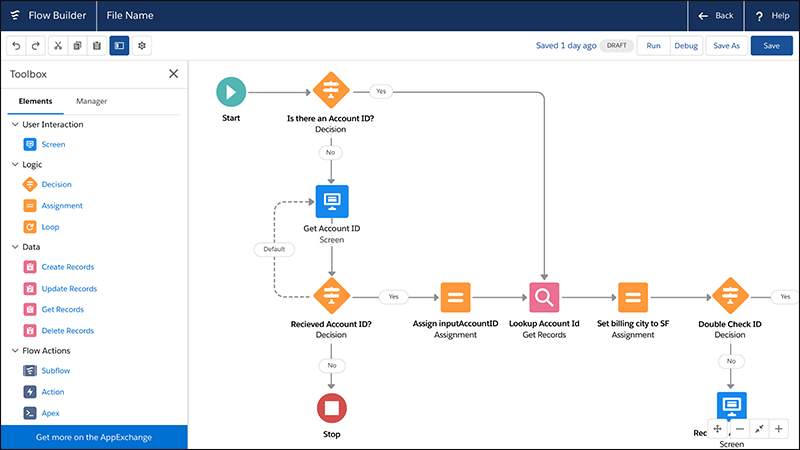Top Suggestions For Deciding On Low-code platforms for application development
Top Suggestions For Deciding On Low-code platforms for application development
Blog Article
The Advantages Of Low-Code Development To Speed Up Development
Visual Development Environment :
Drag-and-Drop Interfaces: Low-code platforms provide visual tools for designing applications. Developers can quickly assemble applications using drag-and-drop components without writing code.
Many low-code platforms include pre-built templates and components that permit developers to quickly build prototypes of their applications and create them without needing to start from scratch.
Reduced Coding Requirements for Coding:
Automated Generated Code: Lowcode platforms create the code base on the visual models that developers have created. It reduces the need to manually code and improves the speed of development.
Reusable component: Developers are able to make use of the same components in different projects. This reduces the time spent developing code and testing.
Collaboration can be made easier.
Integrated Development Tools : Low codes platforms usually have tools for testing, version control and deployment. They help facilitate collaboration between teams.
Citizen Development: Non-developers and business users can utilize intuitive interfaces to contribute to the development of applications, which reduces bottlenecks caused by a shortage of professionals to develop applications.
Rapid prototyping, rapid iteration, and rapid prototyping
Rapid prototyping: Developers are able to quickly create prototypes to validate ideas and get feedback, resulting in quicker the cycle of iterations.
Easy Modifications: Low-code design is oriented towards visuals, which makes it much easier to modify and upgrade applications. It also speeds up the process for refining and optimizing applications in response to user feedback.
Pre-built Integrations:
API Integrations. Low-code platform often come with pre-built connectors as well as APIs for services that are popular that reduce the amount of time required to integrate with other systems.
Data Integration: Built in tools for data-integration make it easier to connect databases and other data sources. This helps speed up development.
The deployment of scaling:
One-Click Embedded Deployment: Many low-code platforms have one-click deployment, greatly cutting down on the time and effort needed to deploy applications.
Cloud-based Platforms: Cloud-based platforms which are low-code allow for the management of infrastructure and scaling, so developers can focus on the logic and performance of their applications instead of the logistics of deployment.
Low-code application development is a faster way to develop applications. It streamlines and automates various aspects of the process. This enables faster delivery and adapting to the changing needs. Read the top rated Low-code Platform for application development for site examples including low code platforms, low code platforms, developing mobile apps, mobile development platforms, cloud software applications, app dev platform, cloud software applications, develop web application, cloud software applications, azure sql server and more.
Benefits Of Low-Code Application Development In Security And Governance
Low-code applications offer several benefits in terms of cybersecurity and governance that are essential to ensure that all apps are well-managed, managed and are compliant throughout their lifecycle. Here are the most significant advantages: Centralized Governance
Unified Management Console (UMC): Low-code applications typically provide a centralized management console, where administrators are able to oversee and manage all applications to ensure a uniform governance throughout the entire organization.
Role-Based Access Control RBAC : These platforms usually include robust access controls that are based on roles. They enable administrators to create and enforce rules. This guarantees that only authorized users can access or modify particular parts of an application.
The Compliance Process and Regulatory Adherence:
The advantages of conformity: Many platforms using low-code have been designed to be in line to industry standards. They have frameworks and tools to help ensure that apps meet the requirements of these regulations.
Audit Trails and Logging Comprehensive logging and audit trails are often combined, allowing businesses to track changes, monitor access and make sure that they are in compliance with internal and external regulations.
Increased Security Measures
Data encryption: Low-code platforms generally provide encryption built-in for data that is in storage and in transit, ensuring that data with sensitive information is secure.
Security Certificates: A lot of low-code companies have a security certificate (e.g. ISO 27001 and SOC 2) which demonstrate that they are adhering to strict security guidelines. They provide an additional level of assurance to clients.
Automated Security Updates
Regular security updates and patches Low-code platforms handle automatically security patches, updates and updates. The applications are thus protected from current threats without requiring manual intervention by developers.
Security Monitoring: Continuous security monitoring tools are included to provide real-time notifications and insights on potential security problems.
Data Governance:
Data Access Policies: These systems enable organizations to define and enforce policies regarding data access which ensure that data access is restricted to authorized users and properly used.
Data Masking Anonymization The built-in tools for data masking and anonymization features help protect sensitive data, especially during development and testing environments.
Consistent Application Lifecycle Management:
Pipelines for Development and Deployment Low-code platforms typically offer integrated pipelines for development and deployment that include security checks to ensure that security is maintained throughout the application lifecycle.
Version Control: The integrated version control helps manage modifications and makes sure that modifications to the application can be monitored and reversed if needed, maintaining the integrity of the application.
User Authentication, Authorization and Authorization
Single Sign-On (SSO): Support for single sign-on as well as other advanced authentication mechanisms simplify management of users and improves security.
Multi-Factor Authentication (MFA) Numerous platforms provide built-in support to multi-factor authentication, adding an extra layer of security when accessing applications.
Monitoring of Policy Enforcement
Policy Templates: Platforms that are low-code typically come with pre-defined policy templates that help organizations quickly establish security and governance policies.
Compliance Monitoring Tools: These give continuous monitoring and a report on the status of compliance. This allows you to detect potential issues and tackle them in a timely manner.
Integration with Existing Security Infrastructure:
Seamless integration: Low-code platforms can be easily integrated with the existing security tools and systems such as firewalls, SIEM products (Security Information and Event Management), and identity management systems.
API Security: Built-in API security features ensure that integrations with external systems are secure, protecting data and maintaining application integrity.
Best Practices and Training:
Many platforms offer guides and best practice for developing secure applications. They assist non-developers to adhere to security standards.
Some lowcode providers provide tools and security education for users to understand how to build and maintain a secure application.
In general, low-code developers provide a security and governance advantage which allows them to create and manage their applications in a safe, secure and secure way. These platforms provide the frameworks and tools needed to protect sensitive data and enforce policies while maintaining regulatory compliance. See the top rated Legacy application modernization with Low-code info for blog advice including rad application development, develop web application, build with docker, azure sql server, app platforms, rapid applications, azure sql databases, rad application development, application development platforms, stored sql procedures and more.
Support From Vendors And Community Are Two Benefits Of Low Code Development For Applications.
Low-code application development platforms are a great method to gain support from the vendor as well as community involvement. Both of these aspects are essential to ensure an effective implementation and continuous maintenance of the application. Here are a few of the principal benefits: Support from the vendor
Comprehensive Technical Support:
Support Teams: Several Low-Code platforms have a an experienced support team that assist with technical issues, guidance and troubleshooting.
Certain vendors provide 24/7 support. This is especially beneficial to global businesses with multiple time zones.
Training and onboarding:
Training programs that are structured: Vendors provide structured courses such as webinars and certification courses. This helps users to quickly grasp the platform.
Personalized Onboarding: A lot of vendors provide personalized onboarding services to help new customers use the platform effectively and tailor it to their specific requirements.
Regular Updates and Enhancements:
Continuous Improvement Lowcode platform providers typically release regular updates with new features, performance enhancements and security patches. This is a way to ensure that the platform is up-to-date and secure.
Feedback Integration: Many vendors integrate user feedback in their process of development. This helps ensure that the platform can adapt to the evolving demands and needs of its customers.
Comprehensive Documentation:
Documentation is thorough: Users are usually able to access a wealth of well-organized documents that range in complexity from basic customization to advanced.
API References API documentation offers complete API references that can help developers integrate their low-code platform applications with other systems.
Consulting and Professional Services
Expert Consulting: Many firms offer consulting services that aid users with complicated implementations and designs for architecture, as well as strategic planning.
Custom Development Services: Some vendors offer custom development services to develop specific features or integrations that aren't available in the standard package.
Community Support for the Community
Active User Communities
Forums and discussion boards A lot of platforms with low-code feature a vibrant community where users can seek help, share solutions and collaborate in finding the most effective techniques.
Local and virtual User Groups and Meetups provide the opportunity for users to exchange experiences, gain knowledge from others, and build relationships.
Knowledge Sharing and Collaboration:
Community-Contributed Resources: Users often share templates, modules, and extensions that they have developed, which can be reused or adapted by others, accelerating development and innovation.
Crowdsourced Solution Finding: The collective experience and wisdom of a group could be a great resource for finding solutions to complex problems.
Development and learning:
Community-Led training: Many communities offer webinars, workshops and training sessions led by experienced users.
Online Tutorials: Community members contribute and share numerous online tutorials, how-tos, and tutorials. These resources are accessible to all.
Feedback and Influence
Product Feedback: Many community forums offer channels to give feedback to manufacturers. This can influence new features and improvements.
Beta Testing Programs: Members of the community who are active may have the opportunity to be part of beta testing programs, which gives the opportunity to test new features and a voice in determining the future of the platform.
Recognition and Encouragement
Community Recognition Programs: Several vendors have recognition programs that recognize the contribution of community members who are active, such as MVP (Most Valuable Professional) programs.
Peer Support: Members of the community often provide peer support, sharing their expertise and providing guidance to users who are not as familiar in a supportive and a supportive atmosphere.
Overall, the combination a robust vendor's support and a vibrant, active community provides a complete assistance system for low-code application development. Users will have the ability to get the help, resources, and collaboration opportunities they need in order to develop, deploy, maintain, and enhance their applications.